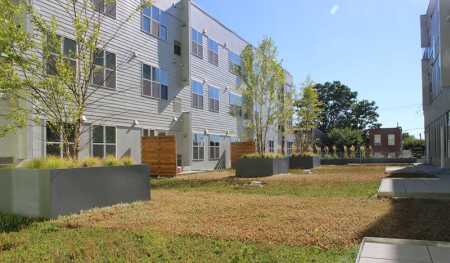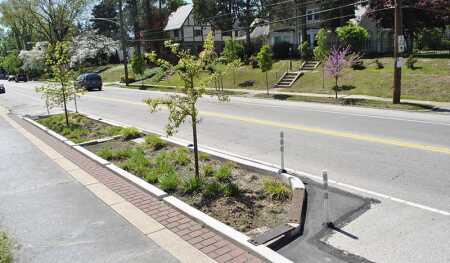In any given year, Philadelphia pumps 11 billion gallons (42 billion liters) of effluent through more than 100 outflows and into the Delaware River, along with numerous smaller waterways. With much of the city saddled to a Victorian-era sewer system that swirls stormwater and human waste together, the Philadelphia Water Department (PWD) does not have much of a choice.
“The old model just piped everything away,” says Chris Crockett, deputy commissioner at the PWD. “But the stormwater washes all the accumulated pollution off streets and parking lots, into the sewers and out into the river.”
To address a problem that is staggering in scale, Philadelphia has already undertaken what Crockett described as “the largest green infrastructure project in the U.S.” The city’s water department has committed to a multibillion-dollar, 45-year-long effort to create 964 acres (390 ha) of new, green space within one of America’s most urbanized and industrialized cities.
Mostly developed as tight rowhome blocks and sprawling industrial tracts, much of the city’s land predates conversations about concepts like “permeable infrastructure.” However, Philadelphia is also a place that surprisingly receives even more annual rainfall than famously waterlogged metropolises like Portland, Oregon, and Seattle. Worse, from a water management standpoint, precipitation increasingly comes in bursts, in the form of sudden, torrential thunderstorms, in some cases exacerbated by climate change, which has intensified downpours in many parts of the United States.
Sluice gates hold back as much stormwater as possible in the city’s sewers while overburdened water treatment plants do their work during a rainstorm. But just 0.1 inch (0.25 cm) of accumulation can overload the system and force out contaminated wastewater, while a typical storm drops around two inches (5 cm) an hour.
Most city dwellers probably do not care—at least, Crockett says, until waste backs up residential sewer lines and floods someone’s basement, or a water main breaks. But there are big-picture costs associated with Philadelphia’s stormwater crisis.
It costs ratepayers millions of dollars annually to maintain overtaxed sewer mains and to treat all the stormwater that flows through the system. The toxic overflow that does not get captured ends up eating away at the banks of the creeks and streams that wind through the city’s bucolic parkland, while depositing litter from city streets, poisoning wildlife and making it unhealthy to swim. If the environmental costs weren’t enough, a consent decree between Philadelphia and the federal government means that the city is legally required to clean up its act.
“The law requires us to clean up and not cause or contribute to water quality degradation. We can’t be polluting the river and streams,” Crockett says. “We have to put in place engineering and infrastructure to remove and treat all that stuff that runs off the parking lots and streets.”
Some of this will come from the thousand-or-so acres of purpose-built green infrastructure the PWD is constructing itself or through the greening of publicly owned property. But changes to local land use policies and the department’s own billing methods also are spurring substantial private investment in green infrastructure, from rain gardens to green roofs to new cisterns.
“Development is our friend. Every acre [0.4 ha] of green development saves us about a million gallons a year,” Crockett says. “Over the long run, private development could get us a third or 40 percent of what we’re trying to do.
In an extensive effort between 1996 and 2010, the department used a form of 3-D LIDAR-based aerial imaging combined with traditional orthography to map out nearly every inch of impermeable surface in the city in order to more accurately assess stormwater fees for commercial property owners.
The fees had been in place for decades, but today, after a four-year phase-in, they are proportional to the amount of runoff a property generates. Crockett says this creates a financial incentive for private owners to, say, invest in green roofs or build planters in once uninterrupted surface parking lots to lower their monthly stormwater fees.
The department used grants to spur early private investment, while working with the city of Philadelphia to restructure its zoning code to make green design elements a requirement for all commercial development over a certain size.
“Development is our friend. Every acre [0.4 ha] of green development saves us about a million gallons a year,” he says. “Over the long run, private development could get us a third or 40 percent of what we’re trying to do. So far, roughly 300 acres [121 ha] of private development have achieved PWD standard.”
While Philadelphia faces some unique challenges, Sarene Marshall, executive director of ULI’s Center for Sustainability, says she believes these kinds of strategies will be coming to many cities, large and small, in the not-so-distant future.
“The big picture is that there are hundreds of cities across America with consent decrees for violations of the Clean Water Act,” she says. “Almost all of those violations are coming from combined sewer flows, and they’re getting worse because of climate change,” and the associated increases in extreme weather.
Marshall says that, for years, the federal government’s advice to cities was simply to “build a bigger pipe”—in other words, crafting elaborate public works projects with massive costs and little spillover benefit. She says that Philadelphia’s strategy of widespread public greening, coupled with private sector engagement, would save taxpayer dollars while contributing to better development, air quality, and recreational benefits.
“Their solution is, ‘Let’s not build a bigger pipe.’ It’s about keeping water out of the pipe,” she says. “Philadelphia is by far the largest city to go down this route. They’re being seen as the poster child for how you can do it differently.”
The city of New Orleans is one big city that has already embraced and innovated on this model. Officials there hope to drive job growth by tackling their own unique water infrastructure challenges, a philosophy encouraged by regular consultation with the government of the Netherlands.
“The Dutch have really inspired the work we’re doing here. They offered their assistance after [Hurricane] Katrina,” says Robin Barnes from the economic development agency of Greater New Orleans, which drafted a comprehensive water management plan for the metro region. “There, they have a percentage of their GDP that comes from water management services. That’s what we aspire to.”
Today, the city is banking on the emergence of an “environmental management” industry around an estimated $6 billion to $7 billion worth of infrastructure improvements planned over the next few decades.
In many ways, the city faces even more environmental obstacles than the Netherlands, where a great deal of land has been reclaimed from the North Sea through damming. New Orleans is similarly constructed, with its infamous levy system protecting many neighborhoods from flooding at the bottom of a giant crater formed from by drained swampland. But it is also continually battered by tropical storms, receiving far more annual rainfall than any Dutch city or any other major U.S. city.
While today’s reinforced levies—along with the construction of several artificial barrier islands closer to the sea—do a better job of keeping water from the Mississippi River or Lake Pontchartrain from flooding in, as Barnes says, “They don’t do much for water that falls from the sky.”
Instead, 148 drainage pumps force water out of the city and into the lake, producing more of the effluent that cities like Philadelphia generate. But even with pumping efforts, flooding of businesses or residences is common during everyday rainstorms. Worse, the city’s clay-rich soil expands during rainfall only to dry and contract as pumping rapidly drains the city, causing extreme subsidence that pushes the city even further below sea level.
The plan that Barnes’s agency put forward is aptly titled, “Living with Water,” and recommends reverting large sections of the city back to a form that is more like the wetlands the city emerged from. In the Gentilly neighborhood, a “resiliency district” is being planned around a $141 million U.S. Department of Housing and Urban Development (HUD) grant that seeks to pilot a method of controlling and retaining water rather than forcing all of it out of the city in an effort to combat subsidence.
“We live in a culture of being dry. But it’s not environmentally friendly and doesn’t allow water to do what it does naturally, which is keep our soil moist,” Barnes says.
Around the site of the former Mirabeau Convent, a 25-acre (10 ha) parcel at the heart of the district, a “water garden” is planned to demonstrate the use of these principles, a proof-of-concept that would encourage application in other neighborhood. Elsewhere, plans are afoot to exclude “floodable areas” of land from development, “greenfit” public buildings, and construct the swales, planters, and permeable sidewalks popping up in other U.S. cities.
But Barnes thinks that despite the size and cost of the New Orleans undertaking, few other cities are as well positioned to realize practical economic gains—gains she says go far beyond keeping water out of neighborhood shops.
“Fifty-three percent of water-related jobs are middle skill jobs, many of those require not much more than a high school degree,” says Barnes. “We look at water as our greatest challenge and our greatest opportunity. The techniques we develop here, we’re [also] going to export.”








